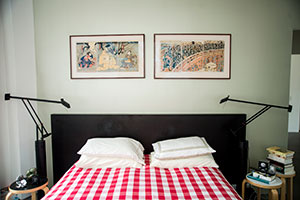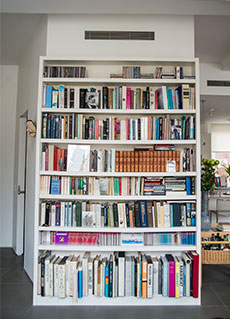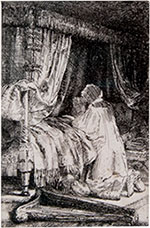Daniel Libeskind on what inspired his World Trade Center plan

Simply sign up to the Life & Arts myFT Digest -- delivered directly to your inbox.
It’s usually closed when guests are here,” says Daniel Libeskind with a grin as he pushes a button that lifts a panel of the living room wall in his Tribeca loft to reveal the master bathroom. “It’s an homage to the hygiene freaks of the 1920s. With Le Corbusier, the first thing was always health. You need to be healthy and washing,” the 67-year-old architect says about the conversation piece.
The living room looks out on to New York City Hall and is flooded with light from windows that stretch the length of the apartment. A small sauna off the bathroom has a tiny window that frames the Chrysler Building. “How does it appear just between these two huge buildings? How is it that it’s aligned?” Libeskind marvels. He discovered the view as the apartment was being constructed. “It’s a mystical result of New York’s rationality. I think it was a product of the grid.”
When Libeskind moved back to New York from Berlin after winning the bid to design the new World Trade Center in 2003, one of his few demands was that he wouldn’t live in a rectangle. “It can be small as long as it’s a wedge,” he remembers saying to his wife and business partner in Studio Daniel Libeskind, Nina. “My wife is a genius – she found this place,” he says of the wedge-shaped building of full-floor residences that sits on the edge of Tribeca, a few steps away from the metro. “It’s beautiful to be on a corner right on top of the subway. You can actually feel it. When you sleep, you feel a slight vibration. It’s the urban life,” he says.
Raised in the Bronx by way of Poland and Israel, Libeskind proudly mentions that he lived with his parents in the first social housing project in the US, the Amalgamated Housing Cooperative. “It was built for garment workers by progressive democrats believing social housing was an important thing in New York.”
One of his many current projects is a housing development for the poorest workers in a newly designed city: Liangzhu, China, 185km southwest of Shanghai. “It’s possible to create dignified, sustainable housing done with a sense of light and pleasure. No one said some place small shouldn’t be beautiful.” To that end, he is keen to help New York’s new mayor, Bill de Blasio, realise his dream of expanded affordable housing.
Libeskind’s egalitarian principles had a big influence on his design for One World Trade Center. “My idea was always very simple: make it as public as you can. There’s 10m sq ft of private office space, but what does it mean for New Yorkers? My father worked as a printer on Stone Street [in the Financial District]. He was down there every day, but my father would never be in those buildings because he lived in the Bronx. He’d be in the subways and on the streets.” Libeskind points out that the eight-acre park at Ground Zero serves as a recreational and contemplative space.

One World Trade Center is a symbolic 1,776ft tall, dwarfing the Le Corbusier building next to it. The dramatic contrast can be seen from Libeskind’s master bedroom, which has a dead-on view of both. He notes that the famed French architect, whom he often quotes, featured a picture of that building in his first book to signal the future of massive skyscrapers. Peering out at both buildings, the word “progress” comes to mind.
If Libeskind has a signature design, it is the curved lines of his buildings that allows light to bounce off their edges so they appear to almost dance in a skyline. And each design is driven by his mantra, “every building deserves a cultural approach”.
It is why, when he stood far above Ground Zero with his fellow finalists on a grim rainy day, he was the only one who wanted to don galoshes and venture 75ft down into the site. It was there that he discovered the “slurry wall” (a 3ft structure that acted as a dam, protecting the building) surprisingly intact and had the idea to preserve it. “I suddenly saw myself as an immigrant coming over by boat. This is the tip of Manhattan, and I thought about the torch of Liberty, the idea of lower Manhattan, power of American democracy and the constitution.”

A tiny book of that legal document rests on a bookshelf in the open living space along with a photo of one of Libeskind’s favourite pianists, Glenn Gould. He prefers Gould’s “Goldberg Variations” from 1955, played with astonishing speed and precision, because “it’s breaking every rule”.
Libeskind had wanted to play the piano as a child but with anti-Semitism rampant in Poland at the time, his parents were scared to bring one through the courtyard of their building. An accordion, fitted inside a suitcase, was a much more clandestine option.
Music is an integral part of what Libeskind calls his “para-architectural” methods. “A lot of people think of architecture in a physical context like physics, but the context is far richer,” he says. “It’s about memory, tradition, things that you cannot see or hear but are there. I always try not to be seduced by the physics of the site. It’s a portal to the past.”
When designing the Jewish Museum in Berlin, his first major international success, he drew inspiration from Arnold Schoenberg’s unfinished opera, Moses and Aaron, for the voids, five cavernous spaces with bare concrete walls that convey the isolation of the concentration camps with shocking power. The “garden of exile,” designed to disorient with a series of uneven columns, tells a story as vivid as an artefact.
As we talk about architecture he admires, Antoni Gaudí’s unfinished masterpiece in Barcelona, the Sagrada Familia, comes up. I ask him if he could imagine working on a building for his entire life and he laughs and says the Jewish Museum felt like that.
Libeskind moved with Nina and his three children to Berlin in 1989 after winning the competition for the Jewish Museum contract, just as the wall was coming down. The museum opened more than a decade later.
“It went through six different governments and name changes,” says Libeskind, whose parents were Holocaust survivors. At one point the project was almost dropped when he received a call from the senator of building and housing. “I knew the building was going to be scrapped because of the cost. It originally had leaning walls, so I said let’s straighten all the walls,” he recalls. It was a compromise that upset many people in his office and caused them to question his vision as an artist.

“It’s about being practical to get your buildings built. How did Le Corbusier get to build the Marseille block or Mies van der Rohe the Seagram? OK, they have great patrons, admittedly,” he concedes playfully as we walk through the open living space in his apartment, minimally furnished with modernist designs like the original Mies chair that sits next to a desk between the dining and living areas.
Besides a guest bedroom tucked away in the back, the space is seamlessly fluid. The entryway, with an exposed fire hose and elliptical exercise machine, flows into the dining, kitchen, and living spaces.
There is no formal office but Libeskind admits to getting work done in the sauna. “It’s such a luxury to meditate for a half-hour and get ideas there. I read that Le Corbusier had a cabin no bigger than the sauna where he used to lock himself. Every architect needs a secret place to get away, even in a relatively quiet house.”
——————————————-
Favourite thing

Libeskind selects an original sketch of Rembrandt’s “David in Prayer” as his favourite thing.
“He was a military leader, but he was also a musician,” Libeskind says of the figure in the drawing. “I love the composition of the darkness and light. It’s kind of a vignette of architecture.
There’s the moment of the Divine. I don’t say you have to pray to be building, but you have to put yourself in a state that isn’t just purely secular to do something good.”
Comments